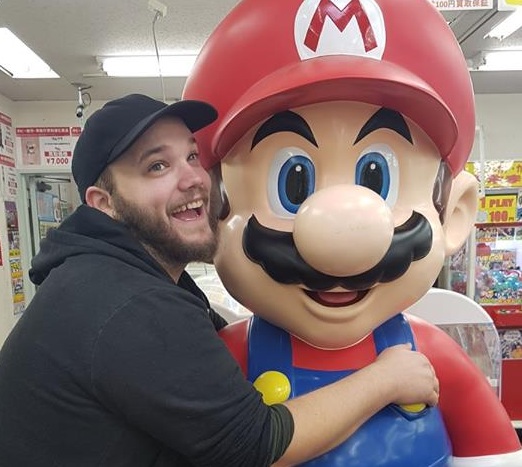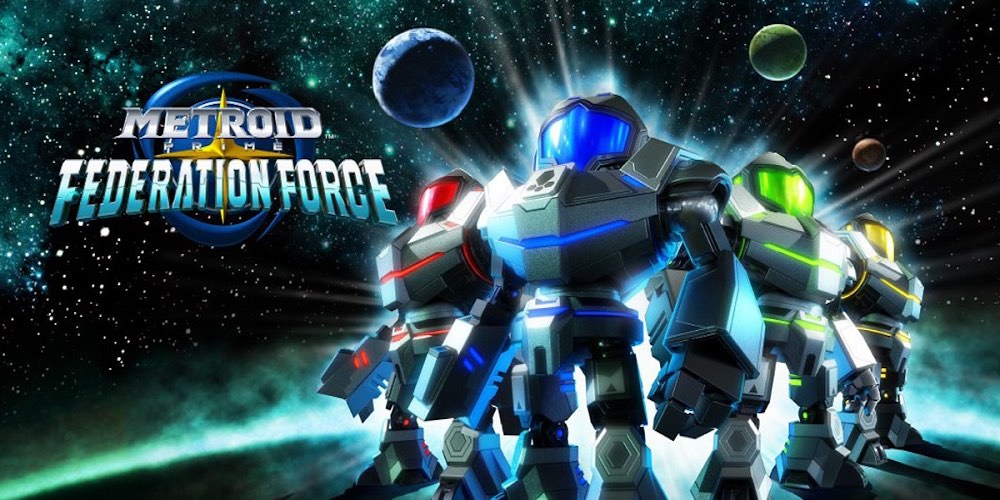
Metroid Prime: Federation Force is the game that no one wanted but was still forced upon us as a less-than-grand way of marking Metroid’s 30th anniversary year. I really wasn’t expecting much going in, in fact, I was expecting it to be outright terrible. Perhaps for this reason alone, I surprisingly found myself enjoying the game… Until I couldn’t anymore. The four-player co-op isn’t an option so much as it’s a requirement, the first few levels being easy enough to accomplish on one’s own until the difficulty ramps a cliff face and shoots into the atmosphere. It’s a shame, because even though I feel like it’s very out of step with the rest of the Prime series, I still enjoyed what I played. If they made some changes to the design, I could even see this becoming its own great spin-off series.
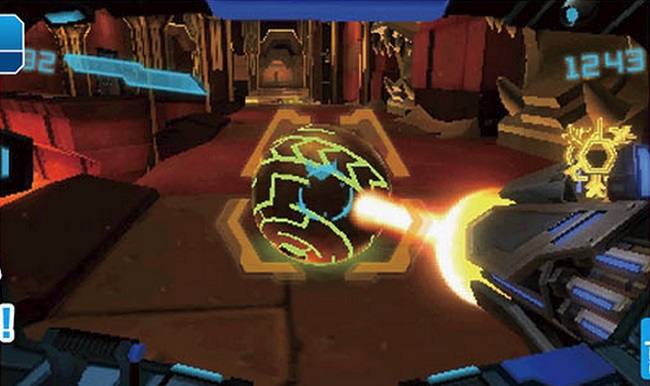
Basically, I don’t hate it and that’s way better than what I thought I’d be saying about this game.
The reason for the “Prime” tag in Federation Force’s title is because the events of the game take place immediately after Metroid Prime 3: Corruption. The destruction of the planet Phaaze and the Phazon, which corrupted and mutated just about everything it touched, was something of a pyrrhic victory for the Galactic Federation. The Space Pirates were weakened but not destroyed, and the Federation had lost an asset that could be potentially used as a weapon. In the wake of these events, the Federation launched Operation Golem – a program based around the building and piloting of massive mechs in case of a Space Pirate resurgence. The Space Pirates do indeed resurge, of course, and the Federation’s newly minted Mech forces are deployed to the three planet system where they’ve been detected.
The mechs themselves are a stripped down, oversized version of Samus’ suit and, in my opinion, the idea behind the whole thing is pretty neat. It’s been established in the series’ canon that Samus is far from the only bounty hunter around and one of the few that can be entirely trusted. Add to that the fact that an “evil version” of Samus appearing wasn’t unique to the events of Corruption and it’s easy to see why the Federation wouldn’t want to rely on just her all the time. A few things happen in the game that suggest there’ll be a continuation in some form in the future (Kensuke Tanabe himself has said he hopes it leads to more Prime games), but the events are otherwise somewhat self-contained. It’s a believable plot that suffers from a rather childish appearance and presentation. It still fits in a lot of classic Metroid tropes, however, while still remaining unique in itself. I would have liked to be able to play it through to the end for myself.
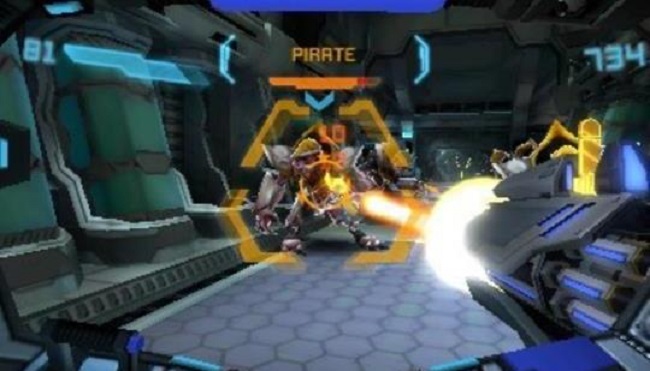
Wait, what?
Yeeeaaahh, the game isn’t really designed for one player to be able to pass on their own. A team of four is ideal, but I would wager you’d be able to get through with maybe just two, assuming you knew the person you were playing with and could actually speak to them somehow. Each planet has a unique theme that dictates enemy and mission types with enough story elements to at least make it a little more than “blam blam, take that space pirates!” From what I played, levels actually tried to employ interesting and unique mechanics or objectives that differed greatly from one another rather than just being “more of the same but harder.” However, they did get harder as time wore on and to a point where it’s just impossible for a single player to beat them. It’s a shame because I would have liked to have played everything the game had to offer.
There is the option of random online matchmaking, but that’s risky at best. It’s a total crapshoot as to whether or not you can even get a game going as there’s always at least one person more interested in customising their mech than actually readying up for a mission. I waited fifteen minutes in a lobby once while someone was supposedly customising their loadout, and I promise you the game’s customisation isn’t that in-depth. Once you’re finally in a game, it’s equally dubious as to whether or not people can even play properly. Nintendo’s insistence on making sure everyone is nice to each other while playing means communication is limited to a handful of pre-set call-outs, none of them being “get on the damn objective.” I don’t personally know a single other person who owns this game, so my multiplayer experience was less than positive.
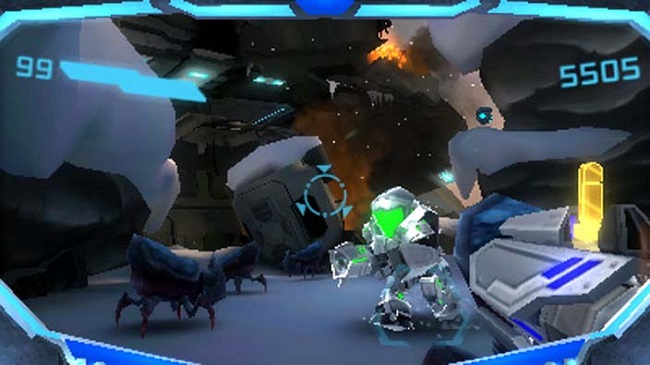
I never could quite tell if the people I played with online were deliberately screwing around or if they actually were total potatoes.
I played Hunters back in the day and its controls were awkward to say the least. That said, Hunters was on the original DS, which wasn’t really built for FPS titles. So, if only for the fact that Federation Force is on the New 3DS with a different button layout, Next Level Games improved the way a handheld, first-person Metroid game controls. Moreover, I feel like the way it was handled even played well into the story. It uses tank controls, moving your mech backwards, forwards and turning side to side with the control stick while using L and R to use different kinds of reticle locks. L-locking onto enemies allows you to strafe, and using R-locking gives you precision aiming with the gyro-sensors of the 3DS and overall it was much smoother than I expected. No, really, I think they did a great job.
It certainly isn’t “smooth,” just smoother than the crap-fest I was thinking it would end up being. Yes, the Mechs are clunky and about four times the size of Samus, but that’s okay because, canonically, they’re the first generation of mechs to be created. The Federation aren’t exactly working with Chozo tech here. They’re a human technological endeavour based on the rough ideas and designs of Samus’ own suit (as far as I can tell, that is. How they were designed is never actually addressed.) Many of the abilities you carry work the same as Samus’ but you’re limited in how many you can carry. They can’t take as much damage, but that’s because they’re not spawned from some ancient, hyper-advanced civilisation. You’re not the galactic chosen one – you’re a grunt, in a uniformed military outfit, on the ground and on the front lines. In a way, it’s why it makes sense that there needs to be four of you.
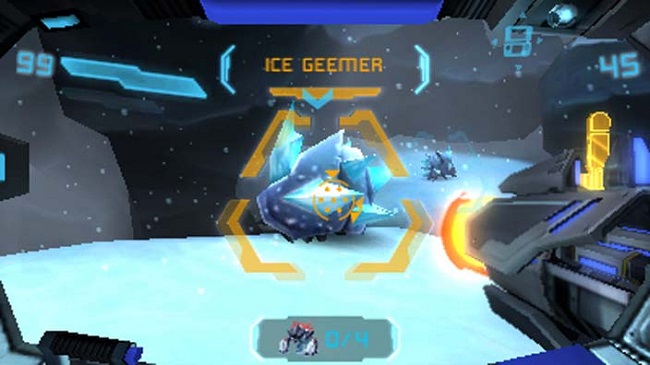
It’s just… you know… I wish that it didn’t need to be like that, so I could finish it on my own.
The game still does a great, if occasionally clumsy job of bringing in some classic Metroid enemies, atmosphere and all around aesthetic. The game does address why some monsters like Space Pirates and bosses are equal to your size, even your in-game commander loses it at the idea that you’re fighting Omega-sized Pirates. This explanation doesn’t extend to everything, however, like how simple Gleemers are now bigger than Samus would be in her regular suit. Once you realise this is the case though, there’s a brief moment of “That’s really awesome!” Then you’ll reach a moment where you start to think about how enormous these challenges would be if you were Samus. And then, like me, you’ll feel a little sad about the fact that you’re not her. It’s a catch-22.
There’s also a very childish, cutesy feel to the whole game that I don’t really think was necessary. It’s as though “Big Head Mode” is perpetually enabled, like everyone is secretly a Mii under those outfits. Even the Space Pirates look pretty non-threatening, and robot enemies could fit right into your average Pixar film. This clashes with some admittedly badass moments that do a fairly good job of capturing some of the feeling and atmospheres that the Prime series is known for. Walking into an apparently abandoned, frozen cave only to have the ground shatter beneath you before being attacked by giant, mutated fish-eel monsters should invoke a feeling of intimidation. It kind of does until you get close enough to them to saw “DAAAWWWWWWW!”
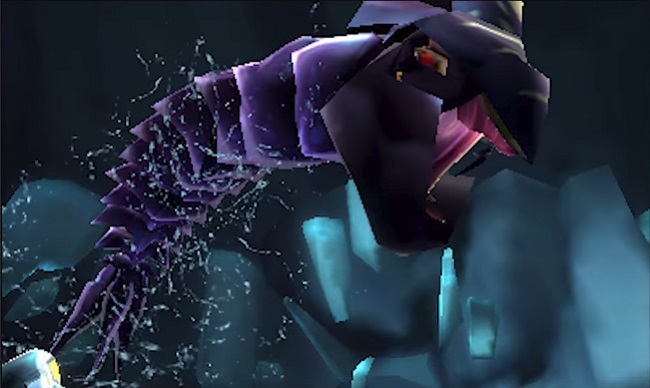
“WHO’S A CUTE WIDDLE CRIME AGAINST NATURE? YES IT’S YOU, YES IT IS!
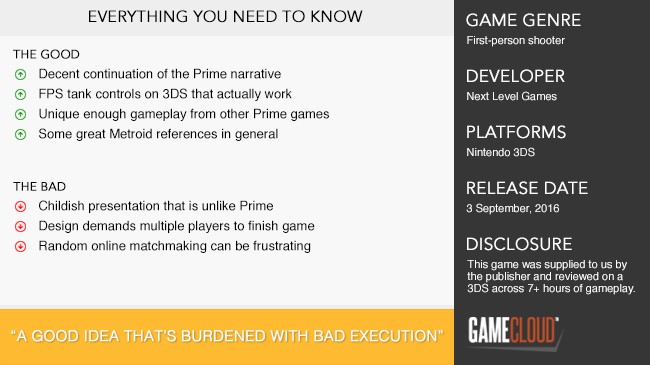
The best praise that I can give to Metroid Prime Federation Force is that I didn’t hate it, and, in fact, wanted to like it a lot more than I did. It really refined the controls of a DS designed FPS, brought a lot of neat, unique ideas into the mix and did its best to make everything cohesive with the existing Prime canon. The choice to design the game in such a way that more than one player is absolutely necessary to pass the game, however, was not a great one, especially given the platform that it’s on. The childish aesthetic also didn’t help things, despite managing to fit in a lot of classic Metroid throwbacks. The idea and concept are solid though, and, honestly, I’d like to see more of this series – just not on the 3DS. Oh, and as an aside: Blastball kind of blows.

